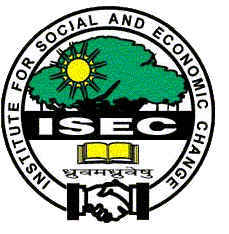| Contents Guidelines for Contributors
Home
|
|
JOURNAL OF SOCIAL AND ECONOMIC DEVELOPMENT
(Published biannually in January and July)
Institute for Social and Economic Change
Bangalore–560 072, India
Editor: M.
Govinda Rao
Managing Editors:
G. K. Karanth, R. Maria Saleth
Associate Editor: Anil
Mascarenhas
Editorial Advisory Board
| Isher Judge Ahluwalia (Delhi) |
J. B. Opschoor (The Hague) |
| Abdul Aziz (Bangalore) |
Narendar Pani (Bangalore) |
| P. R. Brahmananda (Bangalore) |
B. Surendra Rao (Mangalore) |
| Simon R. Charsley (Glasgow) |
V. M. Rao (Bangalore) |
| Dipankar Gupta (Delhi) |
U. Sankar (Chennai) |
| G. Haragopal (Hyderabad) |
A. S. Seetharamu (Bangalore) |
| Yujiro Hayami (Tokyo) |
Gita Sen (Bangalore) |
| James Manor (Brighton) |
K. K. Subrahmanian (Thiruvananthapuram) |
| M. R. Narayana (Bangalore) |
A. Vaidyanathan (Thiruvananthapuram) |
DTP: B. Akila
Aims and Scope
The Journal
provides a forum for in-depth analysis of problems of social, economic, political,
institutional, cultural and environmental transformation taking place in the world today,
particularly in developing countries. It welcomes articles with rigorous reasoning,
supported by proper documentation. Articles, including field-based ones, are expected to
have a theoretical and/or historical perspective. The Journal would particularly encourage
inter-disciplinary articles that are accessible to a wider group of social scientists and
policy makers, in addition to articles specific to particular social sciences. The Journal
also gives scope to Research Notes, Comments, Book Reviews and Review Articles.
All correspondence to be addressed to:
Editor
Journal of Social and Economic Development
Institute for Social and Economic Change
Prof. V. K. R. V. Rao Avenue
Nagarabhavi P.O.
Bangalore 560 072, India
Copyright
Copyright rests with the authors of the respective papers, who alone are
responsible for the views expressed.
Journal of
Social and Economic Development
| Vol. III
July – December 2001
No. 2 |
| Articles |
|
New Perspectives on Land Reforms in India
G. Thimmaiah |
179 |
On an Index of Discrimination
S. Subramanian |
199 |
Risk and Resource Analysis of Rainfed Tanks
in South India
I. Sekar and C. Ramasamy |
208 |
Fertility Transition and Threshold Estimation:
A DistrictLevel Analysis in India
Abhiman Das |
216 |
Poverty and Economic Change in Kalahandi, Orissa:
The Unfinished Agenda and New Challenges
Sunil Kumar Mishra |
245 |
| Book Reviews |
G.S. Bhalla and Gurmail Singh. Indian Agriculture:
Four Decades Of Development
- Ramesh Chand |
266 |
Werner Menski. South Asians and the Dowry Problem
- M. D. Usha Devi |
268 |
Sunil Misra (ed.). Voluntary Action in Health and
Population: The Dynamics of Social Transition
– B.P. Sarath Chandran |
270 |
Biswamoy Pati (ed.) Issues in Modern Indian History
- B. Surendra Rao |
273 |
Datta Ray, B., H.K. Mazhari, P.M. Passah and
M.C. Pandey (eds.) Population, Poverty and
Environment in North-East India
- M.K. Ramesh |
275 |
U. Sankar. Economic Analysis of
Environmental
Problems In Tanneries and Textile Bleaching and
Dyeing Units and Suggestions for Policy Action
– P.K. Viswanathan |
276 |
Manikuntala Sen. In Search of Freedom:
An Unfinished Journey
- Meera Chakravorty |
279 |
Henry Skolimowski. Dharma, Ecology and
Wisdom in the Third Millennium
– K. V. Raju |
282 |
A. Vaidyanathan and P. R. Gopinathan Nair (eds.).
Elementary Education in Rural India: A Grassroots View
– Shashi Rao |
285 |
Remote Sensing and Agricultural Statistics:
Rationale, Scope and Aims, Proceedings of National
Seminar (April 21-22, 1998), Supplement to Indian
Journal of Agricultural Economics
- H K Amar Nath |
288 |
| Books
Received |
291 |
| Index |
292 |
Guidelines for
Contributors
Only
articles/research notes/book reviews not published and not under review for publication
elsewhere should be sent; a declaration to this effect should accompany the manuscript.
Manuscripts
should be submitted in duplicate, in a maximum of 30 pages (of A-4 size), typed
double-spaced in 12-point font (Times New Roman); 15 pages of similar specifications for
research notes. These limits are inclusive of tables, figures and references. Once an
article is accepted, the author is required to provide the final version both in hard copy
as well as on a floppy disk (3.5") prepared in MS Word.
Manuscripts
should be accompanied by an Abstract of less than 150 words. Illustrations, figures, maps,
graphs, etc., should be submitted on separate sheets, and should be kept to the minimum.
Single quotes should
be used for all quotations; double quotes only within single quotes. Non-English words
should be underlined or in italics; spellings of such terms should be consistent in the
article.
All notes
should be numbered consecutively and appear as end notes; notes for tables should be
marked with (*), @, #, etc., and should appear at the bottom of the table. Sources of
data, if from other than one’s own research, should be listed below each table.
References
should follow the author-date system, e.g., Rao (1974:78) or (Rao 1974:78).The list of
references should be in alphabetical order, multiple references to the same author for the
same date should be distinguished by suffixing a, b, c, etc., to the date. (e.g., Rao
1974a:78; 1974b:106–7). The style of referencing should be as
follows: Beteille, Andre (1996). Sociology and Common Sense. Economic and Political
Weekly, 31(35–7):2361–5.
Govil,
Kailash Chandra (1991). Why do Farmers Plant Trees? — A Temporal and
Spatial Analysis for Uttar Pradesh, India. A Ph.D. Dissertation, Berkeley:
University of California. Unpublished.
Rao, V. K. R. V. (1983).
India’s National Income 1950–1980. New Delhi: Sage.
Srinivas, M. N. (ed.)
(1996). Caste — Its Twentieth Century Avatar. New Delhi: Viking, Penguin
India.
Authors
should ensure that References have all the necessary details and are accurate in respect
of the spellings of authors, volume and issue number of journals and page numbers cited.
Material should be
arranged under appropriate sub-headings and not section numbers.
|
